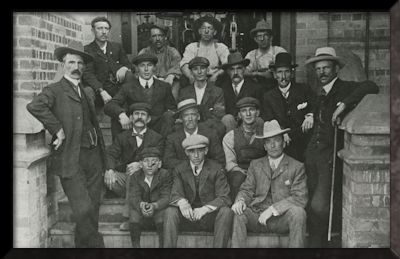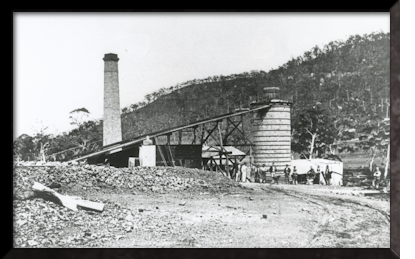|
|
|
|
||||||
|
|
IRON MAKING BEGINS AT THOMAS BROWN’S PROPERTY ‘ESKBANK’ Iron ore was also visibly present on the ground in the Lithgow Valley. Iron production went hand in hand with steam, and steam was powered by coal, so Lithgow was irresistible to businessmen, entrepreneurs and migrants from South Wales and the Black Country of England who knew iron and coal. However, it seems few could manage the technological challenges of producing quality iron, let alone deal with the commercial and political challenges of an iron market that was filled with British pig iron that came in as ship ballast. Nor could they resolve the personal and financial challenges of conducting business in an age when capital was scarce and the issue of government regulation and tariffs was hotly contested.
Enoch Hughes, a British ironmaster possessed of a corrosive, big talking personality, had worked at the blast furnace in Mittagong and brickworks in Sydney before heading to Lithgow. He tried to start the Great Western Iron and Coal Company at Piper’s Flat, but drove his investors away so the valuable resources there were never developed. Hughes then turned his attention to Lithgow, leasing 100 acres of the Eskbank estate from Thomas Brown. Hughes successfully smelted iron at Eskbank on 1 January 1875. His venture was aided by an enthusiastic entrepreneur, Daniel Williams, a NSW Government rail contractor, who formed the Eskbank Iron Company, with Brown, William Whitney, John Sutherland and American Cobb & Co. founder James Rutherford. Rail manufacture and rolling became its core business, boosted by the successful supply of 60 tons of cast iron for columns, riveted plate girders and light tram rails to the Sydney International Exhibition.
After local coal proved unsuitable for coking, Hughes sought ore from further afield, adding to costs. His plant, the construction of which remains a deep mystery, was inefficient. Williams became ill in 1880 and Hughes tried to hide his technical problems, jeopardising government contracts. To stabilise the business and reduce the price of coal being supplied to the plant, Rutherford bought the entire Eskbank Estate—ironworks, land and collieries— from Brown for £45,000. Hughes left in 1883, though remained a vexatious litigant. As with the coal industry, many workers came from the Black Country of England and brought their industrial culture with them. They worked extremely hard, in a sometimes deadly enterprise. Along with the industrial culture came strikes and although Rutherford developed the Eskbank Iron Workers Co-operative Association in 1882, to keep the plant running, employer and employees often feuded. However, both were affected by cheap iron imports and both were protectionists. Rutherford was apparently easy to get along with, and his subdivisions of the Eskbank Estate eased housing shortages. Ironmaking was further developed by William Sandford, who took over in 1886. The full story of iron making is told by the Furnace, Fire and Forge Heritage Trail, a partnership between Lithgow State Mine Museum, the former Lithgow Historical Society, Lithgow City Council and the NSW Heritage Office, launched in 2006. Key sites to pick up the trail are the Blast Furnace Park and State Mine Gully, where the State Mine Heritage Park and Railway is based.
SOURCES Bob McKillop, Furnace, Fire and Forge: Lithgow’s Iron and Steel Industry 1874-1932, 2006 Home | About | Chronological List | Contact Email
|
|
||||||
|
|
|
|



